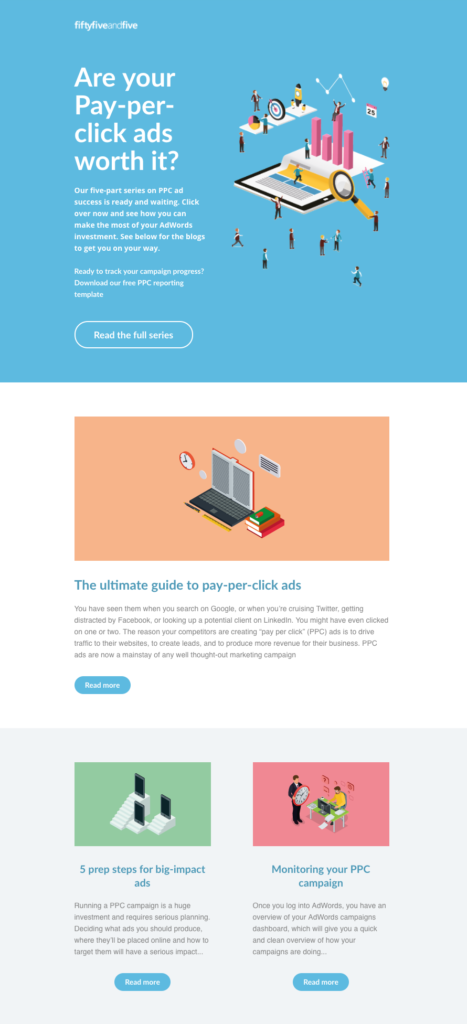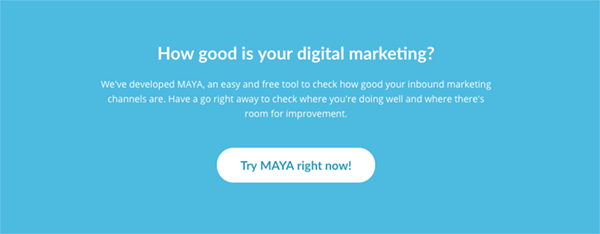Welcome to the second post in our email marketing series, where we’re going to help you master your email copywriting. Before we get started, you should make sure you know the difference between email campaigns and monthly newsletters; make sure you’ve established your goals and built up your email subscriber list.
If you don’t know how to do those yet, you should read the first post in our series before you go any further! Think of this post as an email copywriting master class—showing you what content to include in your emails and teaching you how to write it well.
Are emails harder to open than ever?
Thanks to stiff competition and declining audience attention spans, it’s more difficult than ever to get your emails read, let alone acted on. So, what sets apart those emails that do engage with their audience? Design is playing an increasingly large part in the success of email open rates, helping create visually appealing and enticing emails. But if your content isn’t up to scratch, then your click rates are going to remain low. And your click rate is arguably more important than open rates when it comes to generating leads.
So how can you make sure your content is as good as it can be? Mastering email copywriting is no small task, but we’ve put together some best practice advice on how you can fill your emails with engaging, appealing and persuasive copy to get your readers taking action on the things you say.
Here are five things you should focus on when it comes to mastering email copywriting.
1. Find the right tone
Emails can be ‘chatty’, so you can let your brand’s personality out a little more compared to blogs or longer-form content. Using merge tags—that identifies a recipient’s email to address them by name—and writing in the second person (using personal pronouns ‘you’ and ‘your’) are good ways to orient the language towards the audience, not the author. As spam is more prevalent than ever, make sure you also use a familiar sender name—this helps the reader connect with you before they’ve opened the email.
2. Create engaging subject lines
The best subject lines arrest the reader’s attention. Keeping them short and using actionable language are the best ways to do this. You need to strike a balance between telling them why they should open the email without giving away exactly what’s inside. Here are some typical angles you should aim to include in your subject lines:
- Create a sense of exclusivity/urgency or personality
- Quote statistics, metrics or testimonials
- Pose a compelling question
- Invoke the mind’s eye
- Use puns or humour
3. Stick to the three C’s
When you are considering your content approach, remember the three C’s above all else: clear, consistent and concise.
It’s easy to get distracted by trying to be witty in order to stand out, but clarity should always come first; humour or entertainment second. The body of your email should cater more towards information than persuasion—leave the latter for your subject lines and headers when you’re trying to arrest the reader’s attention. Once they’ve opened the email, you need to be clear and to the point, making it as easy as possible to understand.
Especially in emails, you should stick to short sentences and paragraphs. Keeping your message on-point is key to writing concise email copy. MailChimp allows for several different styles of content layout, so the length of your content will likely vary depending on the layout. Here’s the kind of layout and text length we stick to at Fifty Five and Five:

You also need to be consistent in your subject line and email body. When readers don’t get what they’re promised in the subject line, click-through rates plummet.
4. What goes into email copywriting
So, you know the type of language to use; what are you going to talk about? Obviously, this varies based on the company. Here are some general goals or aims you could offer your audience:
- Advice/Guidance
- Interest/Opinion
- News
- Interviews
Many companies’ emails only explain the features of new products or services they are offering, when they should be explaining the benefit. Instead of announcing a new edition of your tool, why don’t you talk about what it can do for the user? What problems can it solve? Understanding the problems and interests of your email recipients is the key to creating emails that will appeal to them.
Another pro-tip: more email is read on mobile than on desktops, and you need to accommodate for this. Make sure your email looks great on any device or browser. Keep the content concise and consistent for every device. MailChimp lets you preview how your campaign will look on desktop, web browser and mobile.
5. A compelling call-to-action
Just like your web copy and blogs, your emails should have calls to action, too, and they should be as clear as possible. People tend to scan emails more than any other kind of content. And call-to-actions will often come at the bottom of the email, where some recipients won’t even get to. That’s why in HTML emails it’s a good idea to include a button prominently displayed near the top of the email body. In fact, buttons are great calls to action across your emails in general—we use them all the time in our own emails.
 Email copywriting, accomplished
Email copywriting, accomplished
You need a balance of all the above to stand out from the crowd and prove your value to your email subscribers. The content you write is the best way to do that; empathise with your audience’s concerns and problems, get them asking questions, and show how you can help them. Email can (and should) be a very personal method of communication. If you get that personality across to your audience, they’ll be more likely to want to get to know you and trust you.
Visual elements can accentuate your content to bring it off the page. Videos, images, and GIFs have all become extremely effective devices for arresting your audience’s attention, and infographics have become immensely popular in recent years too within email campaigns. But more on that next time!
Make sure you tune in for the next post in our email marketing series on the role of design. If you want more information on creating the best content for your email campaigns or monthly newsletters, don’t hesitate to get in touch with us today.


